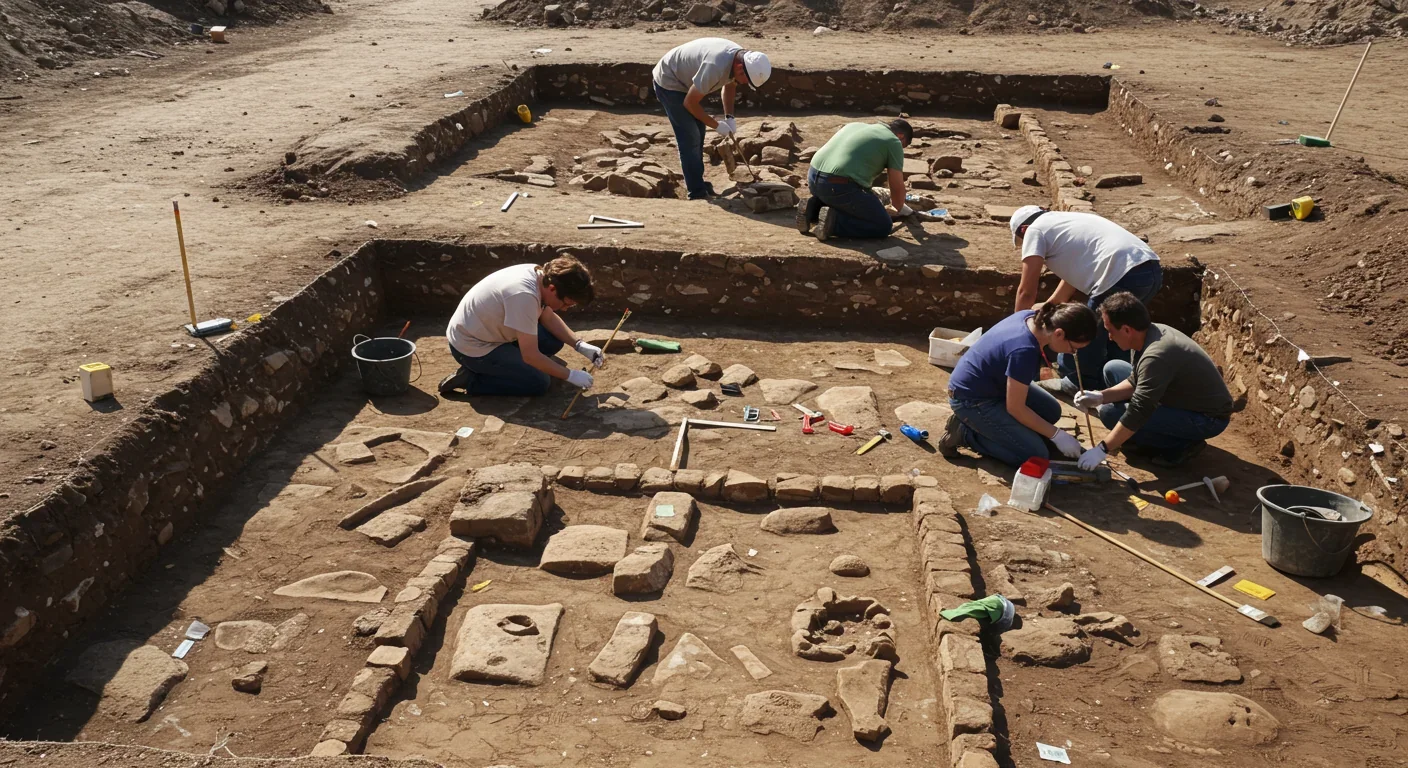Why Your Brain Sees Gods and Ghosts in Random Events

TL;DR: Human cooperation evolved through kin selection, reciprocal altruism, and group selection, amplified by language, shared norms, and cultural transmission. From small hunter-gatherer bands to modern nations, we've scaled cooperation through institutional innovation—though today's global challenges test whether we can cooperate fast enough.

Imagine two early humans facing a woolly mammoth. Alone, each would flee. Together, they could strategize, coordinate their attacks, and bring down prey that could feed their entire group for weeks. This simple scene captures humanity's defining trait: we cooperate on a scale no other species can match. While other animals work together in limited ways—bees in hives, wolves in packs—humans built sprawling cities, democratic institutions, and global supply chains. What evolutionary quirk turned a vulnerable primate into the planet's most cooperative species?
Cooperation didn't emerge from thin air. It's woven into our biology through three evolutionary mechanisms that shaped how our ancestors survived.
Kin selection explains why you'd risk your life to save a sibling. When you help close relatives survive and reproduce, you're essentially helping copies of your own genes persist. Studies of eusocial insects reveal this principle in extreme form: worker bees sacrifice their own reproduction to help their queen because they share more genes with their sisters than they would with their own offspring. In humans, this translates to the fierce protection parents show their children and the bonds between siblings.
Reciprocal altruism takes cooperation beyond family. You scratch my back, I'll scratch yours—but only if you remember who helped you before. Chimpanzees actively solicit help when needed and recall past partners to recruit the most effective ones for future tasks. Early humans who could track favors, remember cheaters, and reward cooperators gained survival advantages. This created pressure for bigger brains capable of social accounting.
Group selection operates at a larger scale. Groups with more cooperators outcompete groups of defectors. When resources are scarce or enemies threaten, societies that share food, coordinate defense, and maintain social cohesion survive while fractured groups collapse. This doesn't mean evolution favors self-sacrifice—it means that under the right conditions, groups of cooperators thrive together.
These three mechanisms created the biological substrate for cooperation. But biology alone couldn't build civilizations. Humans needed something more.
If cooperation is so advantageous, why didn't other smart, social animals develop it to our extent? The answer lies in uniquely human cognitive and cultural tools.
Language changed everything. Other primates communicate through calls, gestures, and facial expressions, but human language allows us to exchange detailed social information. We can warn others about specific threats, coordinate complex plans, and—crucially—talk about people who aren't present. Research shows that the superior scale and range of human cooperation comes mainly from the ability to use language to exchange social information. Gossip isn't just entertainment; it's how we track reputations, identify cooperators, and ostracize cheaters.
Shared norms and enforcement provide the scaffolding for large-scale cooperation. Even chimpanzees punish competitive behaviors within groups, reducing free-riding. Humans took this further, developing elaborate systems of rules, punishments, and rewards. Hunter-gatherer societies enforced sharing through social pressure and mockery. Agricultural societies created laws and dedicated enforcers. Modern nations build institutions—courts, police, regulatory agencies—to maintain cooperative norms across millions of strangers.
Cultural transmission allows cooperation strategies to accumulate across generations. A child doesn't need to rediscover that sharing increases group survival; they learn it from parents, stories, and observation. Successful cooperative practices spread through imitation and teaching, creating cultural evolution that operates much faster than genetic evolution. One generation might develop a new farming technique; the next improves irrigation; soon an entire civilization emerges from accumulated cooperative innovations.
For most of human history—roughly 300,000 years—our ancestors lived in bands of 20-150 people. These hunter-gatherer societies were egalitarian by necessity. Everyone knew everyone else. Reputations were transparent. Cheaters faced immediate social consequences. Cooperation was personal, direct, and essential for survival.
Food sharing typified this era. When a hunter killed a large animal, the meat was distributed throughout the band. This wasn't pure altruism—it was insurance. Today you're successful and I'm hungry; tomorrow our positions might reverse. By establishing reciprocal sharing, bands created safety nets that reduced individual risk.

The agricultural revolution, beginning around 10,000 years ago, transformed cooperative dynamics. Farming required new forms of coordination: synchronized planting and harvesting, irrigation systems, food storage, and defense of settled territories. Villages grew larger than the 150-person groups that characterized hunter-gatherer bands.
This scale created a crisis for cooperation. You couldn't personally know everyone. Anonymous free-riders could exploit community resources. Traditional social enforcement mechanisms broke down. Yet somehow, human societies not only survived this transition but exploded in size and complexity.
Early agricultural societies solved the cooperation crisis through institutional innovation.
Religious beliefs created supernatural enforcers. If the gods punish oath-breakers and reward the righteous, people cooperate even when human authorities aren't watching. Archaeological evidence suggests that as societies grew larger, their gods became more moralistic and punitive. These "Big Gods" sustained cooperation among strangers who might never interact again.
Hierarchies and specialization emerged as villages became cities. Not everyone could farm; some specialized in pottery, metalworking, or record-keeping. This division of labor required sophisticated cooperation across different roles. Hierarchies—however unequal—organized large-scale projects that no individual could accomplish: irrigation canals, defensive walls, monumental architecture.
Legal codes formalized cooperation rules. Hammurabi's Code (circa 1750 BCE) detailed punishments for dozens of offenses, creating predictable consequences that promoted trust. If I know thieves face harsh penalties, I'm more willing to trade with strangers. Written laws allowed cooperation to scale beyond personal relationships.
Markets and money facilitated cooperation among people who didn't share values, languages, or cultures. Exchange systems allowed strangers to cooperate through impersonal transactions. A Phoenician merchant could trade with an Egyptian farmer without shared religious beliefs because money created a common language of value.
These innovations transformed human cooperation from a personal, reputation-based system into an institutional, rule-based one. City-states emerged, then empires, then nation-states—each representing a quantum leap in the scale of human cooperation.
Today's cooperation challenges dwarf those faced by our ancestors. Climate change requires coordination among 195 nations. Supply chains link workers across continents. Financial systems depend on trust between millions of strangers. Yet the same evolutionary and cultural mechanisms that helped our ancestors still shape modern cooperation.
Institutions remain critical. International organizations like the UN, WHO, and WTO attempt to coordinate global cooperation on health, trade, and security. Their effectiveness varies, but they represent humanity's most ambitious efforts to cooperate across cultural and political boundaries. When these institutions function well, they prevent conflicts, facilitate trade, and solve collective problems. When they fail, the consequences—wars, pandemics, economic crises—remind us how fragile large-scale cooperation remains.
Technology amplifies both cooperation and its breakdown. The internet connects billions, enabling unprecedented collaboration on projects like Wikipedia, open-source software, and scientific research. Studies show that even three-year-olds share rewards equitably after cooperation, suggesting deep-rooted fairness norms. Yet social media also spreads misinformation, polarizes societies, and enables new forms of cheating and exploitation. Our ancient cooperation instincts struggle with digital-scale interactions.

Tribalism persists. Evolution shaped us to cooperate within groups and compete between them. Research comparing chimpanzees and bonobos reveals that chimps are xenophobic while bonobos are xenophilic—and humans display both tendencies. We cooperate intensely with our "tribe" (however defined) while viewing outsiders with suspicion. Modern challenges require expanding our circle of cooperation to include all humanity, but our instincts haven't caught up.
Inequality threatens cooperation. When rewards are distributed unfairly, cooperative systems break down. Research on fairness norms shows that cooperation depends on perceived equity. Rising inequality within nations and between rich and poor countries strains the social contracts that make large-scale cooperation possible. History suggests that extreme inequality eventually triggers conflict or institutional collapse.
Understanding cooperation's evolutionary roots offers practical insights for navigating modern challenges.
Transparency and reputation matter. Cooperation thrives when behavior is visible and reputations are tracked. This explains why corruption flourishes in opaque systems and honest dealing in transparent ones. Blockchain advocates argue that distributed ledgers could create transparency without central authorities. Whether or not that specific technology succeeds, the principle holds: visible behavior promotes cooperation.
Enforcement must be credible. Free-riders destroy cooperative systems if left unchecked. Effective institutions detect and punish cheaters while rewarding cooperators. This doesn't require draconian measures—even chimpanzees use social punishment effectively. The key is consistency and certainty, not severity.
Cultural evolution can outpace genetic evolution. We're not trapped by our evolutionary past. Humans have created cooperative systems that would astonish our hunter-gatherer ancestors: multinational corporations, international law, global aid organizations. These cultural innovations show that we can design institutions that amplify our cooperative instincts while constraining our competitive ones.
Small-scale cooperation remains foundational. While we've scaled cooperation to global levels, our brains evolved for small-group interactions. Research shows that tolerance levels and strong social bonds predict cooperative success. Workplace teams, neighborhood associations, and friend networks continue to provide the personal cooperation that sustains individual wellbeing. Neglecting local cooperation while focusing on global challenges leaves people disconnected and unmoored.
Every human achievement stems from cooperation. The device you're reading this on represents thousands of people cooperating to mine minerals, design circuits, write software, manufacture components, and deliver products. The knowledge in this article builds on centuries of accumulated research, itself a cooperative enterprise spanning generations and continents.
Yet cooperation isn't automatic or inevitable. It requires active maintenance: building trustworthy institutions, enforcing norms fairly, distributing rewards equitably, and expanding our circle of concern. The same species that cooperated to build cathedrals also cooperated to wage wars. The mechanisms that enable cooperation can be weaponized for conflict.
The next century will test human cooperation like never before. Climate change, pandemics, artificial intelligence, and resource scarcity require unprecedented global coordination. We possess the cognitive tools, cultural knowledge, and institutional frameworks to meet these challenges. Whether we actually cooperate at the necessary scale remains uncertain.
But we know this much: cooperation isn't some recent invention or fragile social construct. It's encoded in our genes, embedded in our cultures, and expressed in our institutions. For hundreds of thousands of years, humans who cooperated outcompeted those who didn't. That legacy gives us reason for cautious optimism. We've solved cooperation crises before—from small bands sharing food to nations negotiating treaties. Each time, we've invented new mechanisms to make cooperation possible at larger scales.
The question isn't whether humans can cooperate. We've proven we can. The question is whether we'll choose to cooperate quickly enough and broadly enough to tackle challenges that affect all humanity. Our evolutionary history suggests we have the capacity. The choice, as always, remains ours.

Recent breakthroughs in fusion technology—including 351,000-gauss magnetic fields, AI-driven plasma diagnostics, and net energy gain at the National Ignition Facility—are transforming fusion propulsion from science fiction to engineering frontier. Scientists now have a realistic pathway to accelerate spacecraft to 10% of light speed, enabling a 43-year journey to Alpha Centauri. While challenges remain in miniaturization, neutron management, and sustained operation, the physics barriers have ...

Epigenetic clocks measure DNA methylation patterns to calculate biological age, which predicts disease risk up to 30 years before symptoms appear. Landmark studies show that accelerated epigenetic aging forecasts cardiovascular disease, diabetes, and neurodegeneration with remarkable accuracy. Lifestyle interventions—Mediterranean diet, structured exercise, quality sleep, stress management—can measurably reverse biological aging, reducing epigenetic age by 1-2 years within months. Commercial ...

Data centers consumed 415 terawatt-hours of electricity in 2024 and will nearly double that by 2030, driven by AI's insatiable energy appetite. Despite tech giants' renewable pledges, actual emissions are up to 662% higher than reported due to accounting loopholes. A digital pollution tax—similar to Europe's carbon border tariff—could finally force the industry to invest in efficiency technologies like liquid cooling, waste heat recovery, and time-matched renewable power, transforming volunta...

Humans are hardwired to see invisible agents—gods, ghosts, conspiracies—thanks to the Hyperactive Agency Detection Device (HADD), an evolutionary survival mechanism that favored false alarms over fatal misses. This cognitive bias, rooted in brain regions like the temporoparietal junction and medial prefrontal cortex, generates religious beliefs, animistic worldviews, and conspiracy theories across all cultures. Understanding HADD doesn't eliminate belief, but it helps us recognize when our pa...

The bombardier beetle has perfected a chemical defense system that human engineers are still trying to replicate: a two-chamber micro-combustion engine that mixes hydroquinone and hydrogen peroxide to create explosive 100°C sprays at up to 500 pulses per second, aimed with 270-degree precision. This tiny insect's biochemical marvel is inspiring revolutionary technologies in aerospace propulsion, pharmaceutical delivery, and fire suppression. By 2030, beetle-inspired systems could position sat...

The U.S. faces a catastrophic care worker shortage driven by poverty-level wages, overwhelming burnout, and systemic undervaluation. With 99% of nursing homes hiring and 9.7 million openings projected by 2034, the crisis threatens patient safety, family stability, and economic productivity. Evidence-based solutions—wage reforms, streamlined training, technology integration, and policy enforcement—exist and work, but require sustained political will and cultural recognition that caregiving is ...

Every major AI model was trained on copyrighted text scraped without permission, triggering billion-dollar lawsuits and forcing a reckoning between innovation and creator rights. The future depends on finding balance between transformative AI development and fair compensation for the people whose work fuels it.